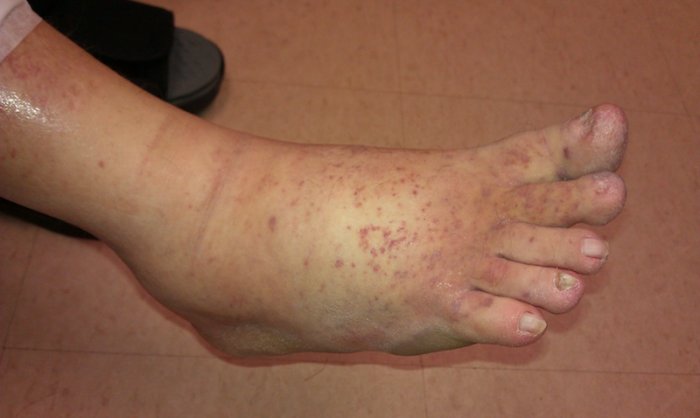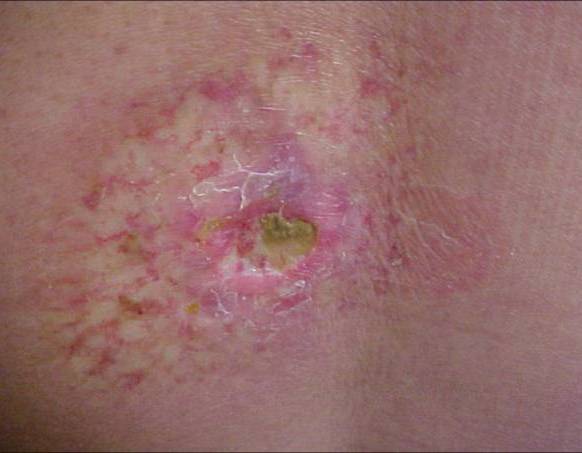CORRECT DIAGNOSIS:
Iatrogenic Kaposi’s Sarcoma (Transplantation associated Kaposi’s Sarcoma)
DISCUSSION:
Kaposi’s sarcoma (KS) is a spindle-shaped vascular cell tumor that occurs in the skin and visceral tissues. Clinically, KS lesions are found to be multicentric and widely dispersed at the onset of disease. The lesions can present as a variety of violaceous to brown-black papules, plaques or patches. The lesions often affect the skin of the lower extremities, but they can be present in visceral tissues such as the gastrointestinal and respiratory tracts.
There are four clinically defined types of KS, which include the classic form, Endemic (African) form, HIV-associated form, and iatrogenic form. Iatrogenic Kaposi’s sarcoma is seen in individuals who are therapeutically immunosuppressed to prevent allograft rejection of transplanted organs. Kaposi’s sarcoma in post-transplant patients is mainly limited to the skin, although reports of visceral KS have been described in this population. The incidence of iatrogenic/post-transplant KS is estimated to be less than 1%, although there is an increasing incidence in developed countries due to the availability and increased use of immunosuppressive agents.
The exact etiology of KS is unknown, although HHV-8 is highly implicated in its pathogenesis. The relationship between HHV-8 and KS was identified in 1994, but and it was determined that HHV-8 is necessary but not sufficient for the development of the malignancy. HHV-8 is a well-established virus that is transmitted via sexual contact and saliva. Once infected, an individual will have the virus throughout his lifetime, which is similar to other herpes viruses. HHV-8 can remain latent for decades and become reactivated given the proper immunosuppressed environment. HHV-8 is able to target tumor suppressor pathways such as the p53 pathway and the retinoblastoma protein, thereby producing tumorigenesis in susceptible immunocompromised individuals.
The incidence of Kaposi’s sarcoma among solid organ transplant recipients has been found to be 500 fold higher than the general population. This is significant when compared to the incidence of other skin cancers in transplant recipients; squamous cell cancer has been described as being increased 65-fold, basal cell carcinoma as 10-fold and melanoma is increased three to fourfold. The incidence of skin cancer is generally thought to be due to the type, intensity, and duration of immunosuppression.
The approach to treating iatrogenic KS involves decreasing or removing the immunosuppressive medications without compromising the body’s acceptance of the graft. This treatment regimen often leads to spontaneous regression of the KS lesions, although reintroduction of immunosuppressants can cause the recurrence of malignancy. Studies have shown that sirolimus (rapamycin), which is an mTOR inhibitor, has both antineoplastic action and immunosuppressive effects that cause regression of KS in kidney transplant recipients. The immunosuppressant effects of sirolimus are also critical in maintaining an antirejection environment on organ allografts.
Treatment modalities involving the use of sirolimus in transplant recipients, in addition to a potential effective anti-herpes virus therapy, have added new opportunities for Kaposi’s sarcoma prevention in transplant recipients.
TREATMENT:
The patient was referred to his renal transplant team to determine the appropriate course of therapy. The mycophenolate mofetil was discontinued and the tacrolimus was maintained at the same dose. The patient began showing regression of his lesions shortly after discontinuing the mycophenolate mofetil. He was also scheduled to initiate treatment with sirolimus to enhance the rate of regression of the KS lesions, as well as provide him with an appropriate amount of immunosuppression to prevent transplant rejection.
REFERENCES:
Schwartz, R. A., et al. (2008). Kaposi sarcoma: A continuing conundrum. Journal of the American Academy of Dermatology, 59(2), 179-206. PMID: 18672171
Stallone, G., et al. (2005). Sirolimus for Kaposi’s sarcoma in renal transplant recipients. New England Journal of Medicine, 352, 1317-1323. PMID: 15863406
Zwald, F. O., O’Reilly, B., & Brown, M. (2011). Skin cancer in solid organ transplant recipients: Advances in therapy and management. Journal of the American Academy of Dermatology, 65(2), 253-261. PMID: 21704533




